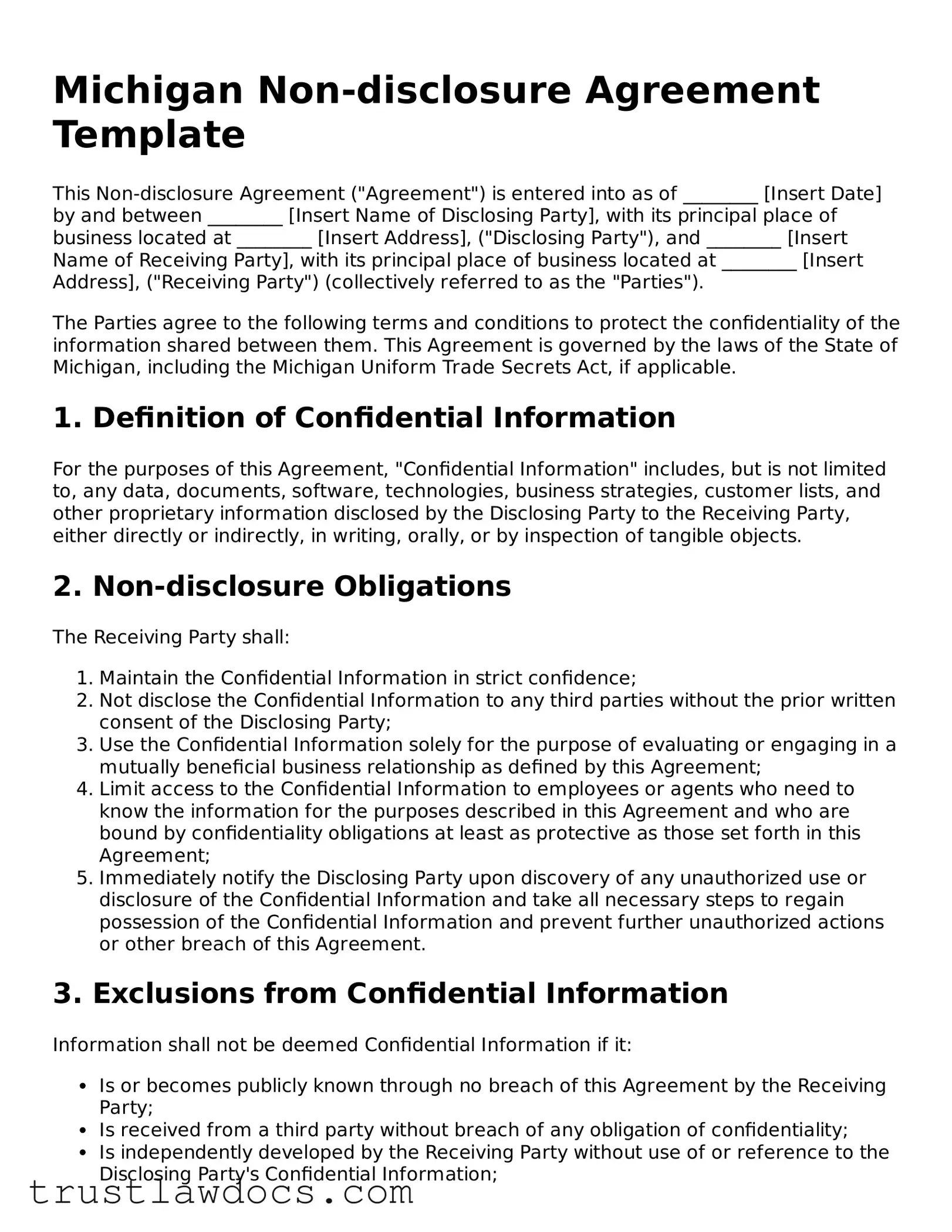Michigan Non-disclosure Agreement Template
This Non-disclosure Agreement ("Agreement") is entered into as of ________ [Insert Date] by and between ________ [Insert Name of Disclosing Party], with its principal place of business located at ________ [Insert Address], ("Disclosing Party"), and ________ [Insert Name of Receiving Party], with its principal place of business located at ________ [Insert Address], ("Receiving Party") (collectively referred to as the "Parties").
The Parties agree to the following terms and conditions to protect the confidentiality of the information shared between them. This Agreement is governed by the laws of the State of Michigan, including the Michigan Uniform Trade Secrets Act, if applicable.
1. Definition of Confidential Information
For the purposes of this Agreement, "Confidential Information" includes, but is not limited to, any data, documents, software, technologies, business strategies, customer lists, and other proprietary information disclosed by the Disclosing Party to the Receiving Party, either directly or indirectly, in writing, orally, or by inspection of tangible objects.
2. Non-disclosure Obligations
The Receiving Party shall:
- Maintain the Confidential Information in strict confidence;
- Not disclose the Confidential Information to any third parties without the prior written consent of the Disclosing Party;
- Use the Confidential Information solely for the purpose of evaluating or engaging in a mutually beneficial business relationship as defined by this Agreement;
- Limit access to the Confidential Information to employees or agents who need to know the information for the purposes described in this Agreement and who are bound by confidentiality obligations at least as protective as those set forth in this Agreement;
- Immediately notify the Disclosing Party upon discovery of any unauthorized use or disclosure of the Confidential Information and take all necessary steps to regain possession of the Confidential Information and prevent further unauthorized actions or other breach of this Agreement.
3. Exclusions from Confidential Information
Information shall not be deemed Confidential Information if it:
- Is or becomes publicly known through no breach of this Agreement by the Receiving Party;
- Is received from a third party without breach of any obligation of confidentiality;
- Is independently developed by the Receiving Party without use of or reference to the Disclosing Party's Confidential Information;
- Is disclosed with the prior written approval of the Disclosing Party.
4. Term
This Agreement shall commence on the Effective Date and shall continue in effect until ________ [Insert End Date], unless otherwise terminated by either party with at least thirty (30) days written notice.
5. Return of Confidential Information
Upon the termination or expiration of this Agreement, or upon the Disclosing Party's request at any time, the Receiving Party shall promptly return or destroy all copies of the Confidential Information received under this Agreement and certify in writing that all such Confidential Information has been returned or destroyed.
6. Miscellaneous
This Agreement constitutes the entire agreement between the Parties regarding the subject matter hereof and supersedes all prior or contemporaneous understandings, whether written or oral. This Agreement may only be amended or modified by a written document executed by both Parties. The failure to enforce any right or provision of this Agreement will not be deemed a waiver of such right or provision. If any provision of this Agreement is held to be invalid, illegal, or unenforceable, the remaining provisions will remain in full force and effect.
Signed on this ________ [Insert Date] day of ________ [Insert Month], ________ [Insert Year], by:
_____________________________________
Disclosing Party: ________ [Insert Name]
Title: ________ [Insert Title]
Date: ________ [Insert Date]
_____________________________________
Receiving Party: ________ [Insert Name]
Title: ________ [Insert Title]
Date: ________ [Insert Date]
